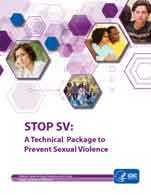Error processing SSI file
Sexual Violence

Sexual violence (SV) is a significant problem in the United States. SV refers to sexual activity when consent is not obtained or not given freely. Anyone can experience SV, but most victims are female. The person responsible for the violence is typically male and usually someone known to the victim. The person can be, but is not limited to, a friend, coworker, neighbor, or family member.
CDC uses a 4-step approach to address public health problems like sexual violence.
- Define the problem
- Identify risk and protective factors
- Develop and test prevention strategies
- Assure widespread adoption
The ultimate goal is to stop sexual violence before it begins.
STOP SV Technical Package
In The Spotlight
- Sexual Violence on Campuses: A Summary of CDC Activities [PDF 144 KB]
- Sexual Violence on Campus: Strategies for Prevention [PDF 3.49 MB]
- Sexual Violence in Youth: NISVS Factsheet [PDF 305 KB]
- CDC releases data from global Violence Against Children Surveys (VACS)
- Understanding Sex Trafficking
- Rape Prevention and Education Program
- The 2010 National Intimate Partner and Sexual Violence Survey (NISVS)
- Connection between Bullying and Sexual Violence Perpetration [PDF 491KB]
- Applying Science. Advancing Practice. (ASAP) is a series of informational briefs to help apply scientific knowledge to the practice of primary prevention of violence.
- Sexual Violence support on our Facebook page
CDC Publications
- Sexual Violence Surveillance: Uniform Definitions and Recommended Data Elements [PDF 2.01 MB]
- Connecting the Dots: An Overview of the Links Among Multiple Forms of Violence [PDF 2.51 MB]
- National Intimate Partner and Sexual Violence Survey (NISVS)
- Sexual Violence Prevention: Beginning the Dialogue [PDF 210 KB]
- Understanding Sexual Violence [PDF 382 KB]
- Page last reviewed: April 14, 2017
- Page last updated: April 14, 2017
- Content source:


 ShareCompartir
ShareCompartir

